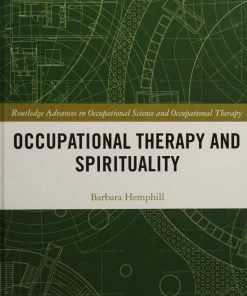Occupational Therapy with Elders strategies for the COTA 4th Edition by Helene Lohman, Sue Byers Connon, Rene Padilla ISBN 9780323498463 0323498469
$50.00 Original price was: $50.00.$25.00Current price is: $25.00.
Occupational Therapy with Elders strategies for the COTA 4th Edition by Helene Lohman, Sue Byers Connon, Rene Padilla – Ebook PDF Instant Download/Delivery: 9780323498463 ,0323498469
Full download Occupational Therapy with Elders strategies for the COTA 4th Edition after payment

Product details:
ISBN 10: 0323498469
ISBN 13: 9780323498463
Author: Helene Lohman, Sue Byers Connon, Rene Padilla
Get the focused foundation you need to successfully work with older adults. Occupational Therapy with Elders: Strategies for the COTA, 4th Edition is the only comprehensive book on geriatric occupational therapy designed specifically for the certified occupational therapy assistant. It provides in-depth coverage of each aspect of geriatric practice — from wellness and prevention to death and dying. Expert authors Helene Lohman, Sue Byers-Connon, and René Padilla offer an unmatched discussion of diverse populations and the latest on geriatric policies and procedures in this fast-growing area of practice. You will come away with a strong foundation in aging trends and strategies for elder care in addition to having a deep understanding of emerging areas such as low-vision rehabilitation, driving and mobility issues, Alzheimer’s disease and other forms of dementia, new technological advancements, health literacy, public policy, dignity therapy, and more. Plus, you will benefit from 20 additional evidence briefs and numerous case studies to help apply all the information you learn to real-life practice. It’s the focused, evidence-based, and client-centered approach that every occupational therapy assistant needs to effectively care for today’s elder patients.
Occupational Therapy with Elders strategies for the COTA 4th Edition Table of contents:
Section 1 Concepts of Aging
Introduction
Chapter 1 Aging Trends and Concepts
Health, Illness, and Well-Being
The Stages of Aging
Demographical Data and the Growth of the Aged Population
Intergenerational Concepts and Generational Cohorts
Ageism, Myths, and Stereotypes About the Aged
Chapter Review Questions
References
Chapter 2 Biological and Social Theories of Aging
Biological Theories of Aging
Psychosocial Theories of Aging
Chapter Review Questions
References
Chapter 3 The Aging Process
Aging
Aging Changes
Integumentary System
Neuromusculoskeletal System
Skeletal System
Cardiopulmonary System
Immune System
Cognition
Sensory System
Summary
Chapter Review Questions
References
Chapter 4 Psychological Aspects of Aging
Myths and Facts About Aging
Stressors, Losses, and Emotions Associated With Aging
Need for Social Support
Physical Illness
Learned Helplessness
Conclusion
Exercises
Chapter Review Questions
References
Chapter 5 Aging Well
Concepts of Health Promotion and Wellness in Occupational Therapy Practice
Prevention and Health Promotion Among Elders
Role of the Certified Occupational Therapy Assistant in Wellness and Health Promotion
Conclusion
Chapter Review Questions
References
Chapter 6 The Regulation of Public Policy for Elders
Introductory Concepts
Health Care Trends in the United States
General Guidelines for OT Payment and Intervention
Skilled and Unskilled Therapy
Medicare Administrative Contractures
Working With Medicare and Related Regulations in Different Payment Systems
Working in Skilled Nursing Facilities
Minimum Data Set
The Prospective Payment System in Skilled Nursing Facilities
Trends With Federal Health Care Policies
Advocacy for Elders
Keeping Up With Changes
Chapter Review Questions
References
Section 2 Occupational Therapy Intervention with Elders
Introduction
Chapter 7 Occupational Therapy Practice Models
Overview of Practice Models
Conclusion
Chapter Review Questions
References
Chapter 8 Opportunities for Best Practice in Various Settings
Occupational Therapy Practitioners: a Collaborative Partnership
Occupational Therapy Practice Framework
Domain of Occupational Therapy
Process of Occupational Therapy: Evaluation, Intervention, and Outcome
Certified Occupational Therapy Assistant/Registered Occupational Therapist Competencies With Evaluation, Intervention, and Outcome Process
Issues Related to Certified Occupational Therapy Assistant Practice
Certified Occupational Therapy Assistants Working With Elders in Various Settings
Conclusion
Chapter Review Questions
References
Chapter 9 Cultural Diversity of the Aging Population
Overview of Cultural Diversity
What Is Culture?
Levels of Culture
The Issue of Diversity
Conclusion
Chapter Review Questions
References
Chapter 10 Ethical Aspects in the Work With Elders
An Overview: Ethics and Elder Care
Awareness: What Is Going on?
Reflection: What Do I Think Should Happen?
Support: With Whom Do I Need to Talk?
Action: What Will I Do?
Conclusion
Chapter Review Questions
References
Chapter 11 Working With Families and Caregivers of Elders
Roles for Certified Occupational Therapy Assistants
Role Changes in the Family
Recognizing Signs and Reporting Elder Abuse or Neglect
Chapter Review Questions
Evidence Brief: Effectiveness of Interventions for Caregivers
References
Chapter 12 Addressing Sexual Activity of Elders
Values About Sexual Activity
Myths About Elders and Sexual Functioning
Elder Lesbian, Gay, Bisexual, and Transgender
Normal Age-Related Physiological Changes in Men and Women
Sexually Transmitted Diseases Among the Elder Population
Role of Intervention in Sexual Education
Addressing Elder Sexual Activity in a Nursing Facility
Educating and Counseling the Elder Client
Effects of Health Conditions on Elder Sexual Activity
Chapter Review Questions
Evidence Brief: Effectiveness of Interventions Addressing Sexual Activity of Elders
References
Chapter 13 Use of Medications by Elders
Factors Affecting Medication Risk in Elders
Polypharmacy
Physiology and the Aging Process
Elder Medication Use and Implications for the COTA
Strategies for Minimizing Medication Problems in Elders
Application of the Occupational Therapy Process to Self-Medication
Client Factors
Activity Demands
Occupational Therapy Process
Assistive Aids for Self-Medication
Self-Medication Program
Evidence Brief: Effectiveness of Interventions to Improve Safety and Compliance of Medication Use by Elders
Chapter Review Questions
References
Chapter 14 Considerations of Mobility
PART 1 Restraint Reduction
PART 2 Wheelchair Seating and Positioning: Considerations for Elders
PART 3 Fall Prevention
PART 4 Community Mobility
Chapter Review Questions
References
Chapter 15 Working With Elders Who Have Vision Impairments
Psychosocial Effects of Vision Impairment
Effects of the Normal Aging Process on Vision
Specific Ocular Pathologies
Visual Dysfunction After Neurological Insult
Warren’s Hierarchy for Addressing Visual Dysfunction
Principles of Intervention
Decreased Acuity
Visual Field Loss
Oculomotor Dysfunction
Reduced Contrast Sensitivity
Impaired Visual Attention and Scanning
Higher Level Visual-Perceptual Deficits
Settings in Which Visual Impairments Are Addressed
Technology for Elders Who Have Vision Impairment
Conclusion
Chapter Review Questions
Evidence Brief: Effectiveness of Vision Rehabilitation for Elders
References
Chapter 16 Working With Elders Who Have Hearing Impairments
Hearing Conditions Associated With Aging
Psychosocial Aspects of Hearing Impairments
Rehabilitation and the Hearing-Impaired Elder
Recommendations for Improving Elder Communication
Providing Assistive Hearing Devices
Conclusion
Chapter Review Questions
Evidence Brief: Effectiveness of Interventions for Improving Function of Elders With Hearing Impairments
References
Chapter 17 Strategies to Maintain Continence in Elders
Urinary and Fecal Incontinence
Cost
Anatomy and Physiology
Etiology
Types of Urinary Incontinence
Fecal Incontinence
Omnibus Budget Reconciliation Act and Related Research
Interdisciplinary Team Strategies
Environmental Adaptations
Clothing Adaptations and Management
Adaptations for Clients With Functional Incontinence
Prevention of Skin Erosion
Chapter Review Questions
Evidence Brief: Effectiveness of Behavioral Techniques in Improving Incontinence of Elders
References
Chapter 18 Dysphagia and Other Eating and Nutritional Concerns With Elders
The Role of the Certified Occupational Therapy Assistant
Normal Swallow
Etiology of Dysphagia
Intervention Strategies
Chapter Review Questions
Evidence Brief: Effectiveness of Behavioral Techniques to Improve Oral Intake and Safe Swallowing of Elders with Dysphagia
References
Chapter 19 Working With Elders Who Have Had Cerebrovascular Accidents
Cerebrovascular Accidents
Occupational Therapy Evaluation
Occupational Therapy Intervention
Chapter Review Questions
Evidence Brief: Effectiveness of Neurodevelopmental Treatment (NDT)/Bobath Approach as Stroke Intervention With Elders
References
Chapter 20 Working With Elders Who Have Dementia and Alzheimer’s Disease
Person-Centered and Occupation-Focused Care for Elders With Alzheimer’s Disease
Intervention
Terminal Stage Issues
Reimbursement for Services
Conclusion
Chapter Review Questions
Evidence Brief: Effectiveness of Environmental Interventions to Reduce Agitation and Wandering of Elders Who Have Alzheimer’s Disease
References
Chapter 21 Working With Elders Who Have Psychiatric Conditions
Assessment
Common Mental Health Disorders
Chapter Review Questions
Evidence Brief: Effectiveness of NonPharmacological Interventions in Managing or Decreasing Psychiatric Symptoms Among Elders
References
Chapter 22 Working With Elders Who Have Orthopedic Conditions
Fractures
Joint Replacements
Arthritis
Chapter Review Questions
Evidence Brief: Effectiveness of Implementation of Hip Precautions After Total Hip Replacement
References
Chapter 23 Working With Elders Who Have Cardiovascular Conditions
Background Information
Psychosocial Aspects of Cardiac Dysfunctions
Evaluation of Elders With Cardiac Conditions
Interventions, Goals, and Strategies
Energy Conservation, Work Simplification, and Other Education
Intervention With Elders With Cardiac Conditions in Other Settings
Chapter Review Questions
Evidence Brief: Effectiveness of Stress Management in Improving Function of Elders with Heart Conditions
References
Chapter 24 Working With Elders Who Have Pulmonary Conditions
Chronic Obstructive Pulmonary Disease
Psychosocial Effect of Chronic Obstructive Pulmonary Disease
Sexual Functioning
Occupational Therapy Assessment and Intervention Planning
Conclusion
Chapter Review Questions
Evidence Brief: Effectiveness of Graded Activity in Increasing Functional Independence of Elders with COPD
References
Chapter 25 Working With Elders Who Have Oncological Conditions
Introduction
Overview of Cancer With the Elder Population
Common Conditions
Cancer Metastasis
Cancer Treatment and Side Effects
Psychosocial Aspects of Oncological Conditions/Implications for Occupational Therapy
Occupational Therapy Intervention
Chapter Review Questions
Evidence Brief: Effectiveness of NonPharmacological Interventions in the Management of Lymphedema
References
Glossary
Bibliography
Index
People also search for Occupational Therapy with Elders strategies for the COTA 4th Edition:
7 occupations occupational therapy
questions occupational therapists ask patients
what is occupational therapy for older adults
is occupational therapy effective
what does an occupational therapist do for seniors
Tags: Helene Lohman, Sue Byers Connon, Rene Padilla, Occupational Therapy, Elders strategies
You may also like…
Medicine - Therapy
Medicine - Therapy
Medicine - Therapy
Occupational Therapy Examination Review Guide 5th Edition Mary Muhlenhaupt
Business & Economics - Mathematical Economics
The International Business Environment 4e 4th Edition Hamilton
Business & Economics - Economics
Languages - English as a Foreign Language & Reference
Basic English Grammar Student Book with Online Resources 4e 4th Edition Betty S. Azar
Medicine - Health-Related Professions











